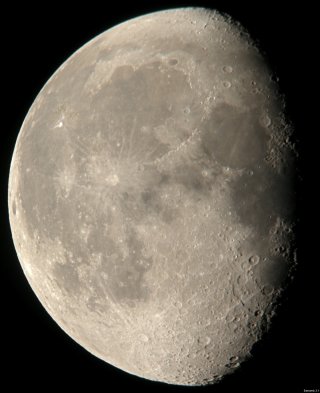The time between full moon and new moon really separates the careful, prepared astronomer from those like me. Anyone, given reasonable weather and a modest amount of time, can get images of the moon when it’s waxing; the waning moon requires much more effort and determination. Last night the moon didn’t rise until 11:06 p.m., when I am normally already asleep. Tonight, it’s not going to rise until after midnight (so technically, it’s not going to rise at all tonight!).
To be able to capture successful images of the waning moon requires not just patience, but preparation as well. I have 14 images taken this morning between 4:24 and 4:30 a.m., but because I went to bed last night without putting my SD card into my camera, I can’t get them off the thing until I find the special USB cable that Nikon cleverly provides with the P5100: smaller even than the “normal” small USB cable head, so no generic that you have lying around your office will work. And furthermore, when you have an SD card in the camera, you can’t read the internal memory of the camera, so you can’t transfer the photos from the camera to the card the way you’d expect to be able to.
Not only that, but if you put the SD card in before trying to read the camera’s internal memory, you’ll have a heartstopping few minutes confronting the message “Memory card contains no images,” and you’ll think all of this morning’s work with the 19-day-old moon will be lost! Fortunately, you’ll probably think to take the SD card out and check the playback feature again, and you’ll discover that you just have to find your d@^~ USB cable before you can see them on the big screen.
But they’ll be great. I promise!
[UPDATE]: RTFM! I just discovered that you don’t need to use the USB cable after all; all you have to do is transfer the pictures from internal memory to the SD card. In fact, the camera’s user manual specifies that for those users foolish enough to use Windows 2000 (which I am not)
To transfer pictures stored in the camera’s internal memory to the computer, the pictures must first be copied to a memory card using the camera.
Which implies, of course, that even if one is not a Windows 2000 user, one CAN copy the pictures to a memory card from the camera; you just have to find the pages in the manual that explain how to do this: 75, 115, and 119. (One of the most frequent complaints about the menus on Nikon’s P&S cameras is how difficult they are to navigate; most users simply find one or two settings they understand, and memorize the ridiculously complicated steps to get there, and forget about the rest of the camera. Suffice to say, I am like most users in this regard, and had no idea that it was possible to copy from internal memory to SD card until I’d read the manual trying to figure out how to do it.)
So, without further ado, here is this morning’s photo of the 19-day-old moon.
The Mare Nectaris is prominent in the southern portion of the moon, with the large crater Fracastorius beginning to take on some shadows. This is an interesting crater, the northern half of which appears to have been swallowed up by the lava flows that created the sea of nectar in the first place; the tops of the rim peaks can still be seen, but all their relief is “underwater,” so to speak. Obviously, then, the crater predates the mare here.
On the northwest edge of Nectaris is the large crater Theophilus; to its east is the small but prominent crater Mädler; continuing east-northeast from there we come to the pair of craters Isidorus and Capella before disappearing into the irregular shadows of the terminator. The terminator is not a clean sharp line here because the terrain is so mountainous; the sun is still poking through the crater rims and valleys to the west.
Jumping quite a ways north, we come to the Mare Serenitatis’s version of Fracastorius, the “ruined crater” le Monnier, which forms a small bay in that larger sea. Just north of le Monnier is the large prominent crater Posidonius, whose eastern rim wall is lit rather brightly by the setting sun, although the shadows behind it (to the east) indicate that the wall is not particularly high. Indeed, Posidonius appears to be mostly a sunken crater, although its eastern portion appears to be substantially more “above ground” than its western side.
One effect of the setting sun that I find quite striking in this photo is the brilliance of the eastern rim of the Mare Imbrium; the Appenine, Caucasus, and Alp ranges are lit up quite nicely with this sun angle, making sunset over this region at least as interesting as sunrise was. The small (only 33 km in diameter) crater Calippus stands out quite nicely in the area between Imbrium and Serenitatis, nestled in the middle of the Caucusus mountains, just to the east of the highest peaks of that range.
The brightest feature in the image is the extraordinary crater Aristarchus; even though it is “only” 40 km across, it is classified as a large crater. It is the brightest large crater on the moon by far, and just about the brightest feature at all; it is assumed to be one of the youngest visible features of the moon, older than Tycho, but, at 450 million years or so, still quite young, considering that the impacts that created most visible features of the moon STOPPED occurring at least 3 billion (that’s three thousand million) years ago!


